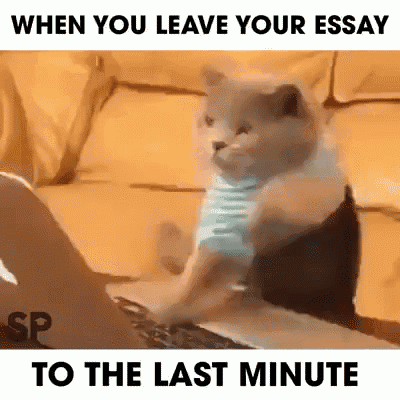Memes and GIFs for Writing Development
As a consumer of social media, I have long been fascinated with memes, particularly those that relate to topics I am invested in, like teaching, literature, or composition. Memes, usually consisting of an image file overlaid by a short text, have become ubiquitous in popular culture. Many are based on images taken from films or TV shows, while others are based on a memorable photo or pair of photos. The humorous text references current events or everyday experiences. Similar to memes, GIF files are omnipresent in social media, particularly reaction GIFs, which are very short video clips showing characters’ facial expressions. Both memes and GIFs can be found through a web search, but can also be created using free and easy-to-use web tools like Canva or Giphy.
As much as I enjoy consuming memes and GIFs in my own social media use, I also see great potential for these formats in supporting second language learners’ writing development. Two recent publications highlight ways that language and writing teachers have drawn on these resources. In this blog post, I summarize these two articles with a focus on how they can be useful for teaching second language writing and suggest additional activities writing teachers might try to bring memes and GIFs into the classroom.
Memes as Intercultural Communication
Memes can be the basis for an ongoing discussion of culture and language between learners and native speakers of a language. In their article “An Ecological Perspective on the Use of Memes for Language Learning,” published in the journal Language Learning and Technology (2023), Yiting Han and Blaine E. Smith report on analyses of a chat group between U.S. college students learning Chinese as a foreign language and Chinese international students at their university. The researchers noticed that both the learners and the native speakers frequently used memes in their posts. When they analyzed the discussions, they found that the learners were able to increase their understanding of Chinese culture as they negotiated the meaning of the memes with the group. Han and Blaine also found that the learners were able to express their own multicultural identities when they chose and created their own memes that bridged U.S. and Chinese cultures.
This study suggests that second language writers can not only learn about culture from consuming memes, but also contribute to culture through creating memes. These are sophisticated language skills:
Being able to read, reply, reproduce, remix, or even create memes in [a second language] requires not only the ability to interpret the words, but also the ability to decipher the information hidden behind the interplay of semiotic resources (e.g., humor, cultural significance, etc.). (p. 156)
According to Han and Smith, the text chat with memes allowed learners to have fun, draw on their existing knowledge of social media, and learn slang in social context through a playful and relatable experience.
Text chats with memes could be something second language writers join outside of class, but the authors of this article also suggest ways that teachers could bring memes into the classroom. One idea is to use memes for teaching intercultural awareness by having the teacher select memes for the class to analyze as a group. Alternatively, students could individually collect memes on a topic to share and discuss with their classmates.

GIFs for Academic Writing
GIFs similarly draw on students’ existing understanding of social media communication. In her article “Using GIFs to Position Students as Scholars” in the journal Prompt (2023), Jamie Henthorn describes a writing assignment that uses GIFs to link students’ informal literacies to new academic writing skills while also positioning novice writers as scholars. Henthorn notes that her first-year college writing students are often intimidated by academic articles and unsure how to read or respond to them. This assignment directs students to analyze a journal article and report on their analyses by incorporating reaction GIFs to represent personal responses to each section of the text. In teaching this assignment over several years, Henthorn has found that even students who struggle to write about their understanding of academic texts are able to find and create apt GIFs to represent that same understanding. The author comments:
GIFs are one way to make analysis feel less formal, and they provide students another way to conceptualize their reactions to a text. Beyond my course, I want my students to see themselves as scholars able to engage with and build on the research they encounter. To do this, they should learn to trust their intuitions and observations about research. (p. 13)
In making the case that this assignment also positions first-year college students as scholars, Henthorn suggests that the process of selecting GIFs helps students recognize that they are in a conversation with the text and their own readers. Students have an investment in representing their reactions accurately so that readers know what worked (and didn’t work) for them in the text. Henthorn’s assignment could be modified for many different writing tasks that require learners to react to a source, from a film or song to a novel.
Note: If you are unfamiliar with the journal Prompt, check it out. It’s an open-access, peer-reviewed journal that publishes nothing but academic writing assignments!

Meme about teaching writing
Other Teaching Ideas With Memes and GIFs
These two articles have prompted me to think about many other ways I might incorporate memes and GIFs into my teaching. As Henthorn notes, these formats bring in a sense of fun while still challenging students to develop essential academic writing skills. Given how many memes and GIFs are freely available on the internet, students can easily search and select ones that best represent the points they want to make.For creative writing, students might choose to start with a meme and make up a story about the situation in the meme. Going the other way, students can select memes or GIFs to retell a familiar story or narrate an original story.
As Han and Smith suggest, memes can also be fruitful prompts for discussions of culture. Students might create memes that represent their home culture for an audience from a different culture. They could also remix memes from one cultural context for a different context by providing text in their new language and editing the visuals (see an example in Figure 4 of Han and Smith’s article).
It’s worth noting that both memes and GIFs are visual forms of communication. Alternatives for visually impaired learners might include using sound clips or adding metatext to make images accessible.
If you’ve developed any activities that connect memes or GIFs with teaching writing, please share your ideas in the chat!

